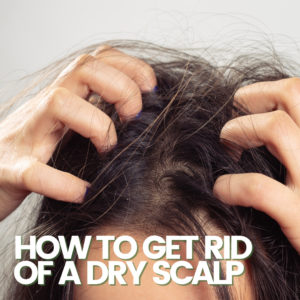How to Get Rid of a Dry Scalp

There is nothing more annoying than leaning in close to the mirror and noticing the small white flakes dotted around your hair parting. Many of us experience a dry, flaky scalp during the winter months as the skin on our scalp struggles to retain moisture, similar to the rest of our body. However, a lot of people mistake their dry scalp for dandruff, although they both have similar symptoms, they are very different. If you feel that you have too much dead skin on your scalp or if it feels dry, then read on for tips on how to treat both and tell the difference between the two.
Difference Between Dandruff & Dry Scalp
The biggest difference is the cause. Dry scalp is due to the skin being irritated and then flaking off, usually, this is because the scalp isn’t getting enough moisture, however, overuse of heated styling tools, a reaction to products, cold, dry air and old age can all be contributing factors. Whilst dandruff is caused by too much oil on the scalp, excess skin cells build up which then fall off. A fungus called Malassezia can also trigger dandruff, this fungus normally lives on your scalp, some people can have too much of it which causes skin cells to multiply more than usual.
Dry Scalp usually results in small, white flakes of dead skin & often you can tell if it’s dry scalp by looking at the skin on the rest of your body, if it is also dry then you will know how to treat it.
Both Dandruff & Dry Scalp give you an itchy head however, Dandruff provides larger, yellow flakes & the scalp can be red and inflamed.
Dirty Hair doesn’t cause dandruff, but not washing it often enough allows oil to build up and flakes of excess skin will fall off.
How to Get Rid Of Flaky, Dry Scalp
Repeat after us: Stimulate, Treat, Condition. Using a gentle shampoo that does not contain alcohol or sulphates will remove the unwanted dry flakes without dehydrating your scalp. We also recommend trying Kérastase Soothing Scrub to remove dead skin, which was specifically designed for sensitive scalps, it’s infused with Jojoba and Sweet Orange Peel to soften and hydrate the scalp. Massaging your scalp during this process is a MUST, use your fingertips to massage in gentle, circular motions. This will stimulate the production of natural oils and increase blood flow to the hair cuticles, which is great because a healthy scalp = healthy hair. Use a moisturising conditioner to bring back the moisture lost & soothe the skin.
SCALP TREATMENTS
How can I hydrate my scalp? Treat the main causes of dryness with a scalp treatment that contains lots of natural ingredients. Make sure it is compatible with your hair type – check out Glamot’s website to learn what hair type you have. If you want a more professional dry scalp treatment, we recommend using the Aveda Prasmasana Protective Scalp Concentrate to soothe, nourish and protect the scalps natural barrier.
For at-home, DIY treatments, try Coconut Oil or Shea Butter for a home Scalp Soak. Leave on for about 20 minutes and gently wash out. Tea Tree oils can be used as a natural anti-inflammatory that relieves itchiness and soothes the skin.
How to Treat Dandruff
Washing hair once a week can seem great for our hair, but it won’t necessarily serve the same purpose if you are prone to dandruff. Since dandruff can be caused by a build-up of oil, it’s important you wash your hair often with a gentle shampoo to reduce the build-up of oil. For Malassezia, use a treatment shampoo that kills off the fungus, you can get these over the counter. If you have tried dandruff shampoo for over a month and the itchiness/flakes haven’t improved then consider meeting with a dermatologist, who specialises in the skin as you may have another skin condition that needs to be treated such as eczema or psoriasis.
Ready to revitalise your scalp? Try out Kérastase Fusio Scrub on your next treatment, specifically designed for sensitive scalps.
